Isle of Man 2023 "50th Anniversary of Manx Wildlife Trust"
| <prev | back to index | next> |
| Issue Date | 17.02.2023 |
| ID |
Gummed stamps Michel: 2963-2967, 2968-2972; Scott: 2278a-e, 2279a-e; Stanley Gibbons: 2871-2880 ; Yvert et Tellier: 2956-2960, 2961-2965; Self-adhesive stamps Michel: 2973-2982; Scott: 2280a-j; Stanley Gibbons: 2882-2890 ; Yvert et Tellier: 2966-2975; Category: pR |
| Designer | Images: Clare Payne, design: Kllbr8 |
| Stamps in set | 10 |
| Value |
80p - Little tern, Sternula albifrons 80p - Hedgehogs, Erinaceus europaeus 80p - Ammonite 80p - Sundew, Drosera rotundifolia 80p - Skullcap, Scutellaria galericulata £1.14 - Dark bush-cricket, Pholidoptera griseoaptera £1.14 - Nudibranch, Polycera spp £1.14 - Scarce crimson and gold moth, Pyrausta sanguinalis £1.14 - Fly agaric, Amanita muscaria £1.14 - Chough, Pyrrhocorax pyrrhocorax |
| Emission/Type | commemorative |
| Issue place | Douglas |
| Size (width x height) | 40.00mm x 31.66mm |
| Layout | Two sheets of 20 stamps, with 5 different stamps in a row |
| Products | FDC x1, Presentation Pack x1, Self-Adhesive Booklet Pane x1 |
| Paper | Gummed FSC Securpost 110 GPW |
| Perforation | 11.5 |
| Print Technique | Offset Lithography, 4 colors |
| Printed by | BPost Philately & Stamps Printing |
| Quantity | Stamps: ?, FDC: 1.500, Presentation Pack: 1.100 |
| Issuing Authority | Isle of Man Post Office |
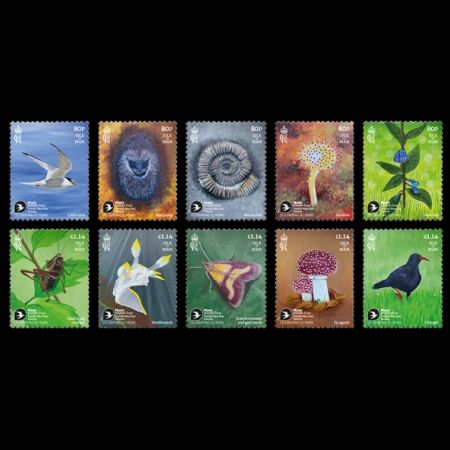
On February 17th, 2023, the Post Authority of Isle of Man issued a set of 10 stamps to commemorate 50th Anniversary of Manx Wildlife Trust.
The artworks were created by the charity's biosphere artist in residence Clare Payne. The stamps highlight the importance of nature conservation and the vast variety of wildlife, flora and fauna that the Isle of Man has to offer.
The sanx Wildlife Trust (MWT) was founded in 1973 and is the Isle of Man’s leading nature conservation charity. Its members, staff and volunteers support MWT to protect Manx wildlife for the future by; driving the development of a nature recovery network across the Isle of Man to create more places for wildlife, enabling nature to improve the wider Isle of Man environment for all, and connecting people in the Isle of Man strongly to nature and inspiring them to act eco-consciously for wildlife.
It all began in 1970, when Felicity Cain and Elizabeth Hamm wrote a rousing letter to the Isle of Man Examiner, calling on Island residents to do something in recognition of European Conservation Year. A meeting led to the formation of the Manx Nature Conservation Trust in March 1973. The first nature reserves were acquired a short time later: Barnell Reservoir in 1974 and Cooildarry in 1976.
Manx Wildlife Trust is a charity which means every penny raised is spent on delivering charitable work - nature conservation in the Isle of Man.
Leigh Morris, Manx Wildlife Trust CEO said:
I’m absolutely delighted with the set of Manx Wildlife stamps that celebrate 50 years of Manx Wildlife Trust! Our Artist in Residence, Clare Payne, has produced ten wonderful paintings that collectively represent a cross section of our wildlife, ranging from sea slugs, to choughs, from fossils to fungi, and from the dark bush cricket to the little tern, our MWT emblem. Every one of the paintings is a work of art, but collectively, they make a fantastic set which we believe will help inform and inspire more people to engage with our spectacular ManxNature
Maxine Cannon, General Manager Isle of Man Stamps & Coins said:
We are thrilled to honour this wonderful charity in their 50th Anniversary year with a stamp issue that has been so beautifully painted by Clare Payne and designed by Kllbr8. Manx Wildlife Trust’s relentless efforts in conservation and nature protection is a fantastic and worthy cause. We hope to support them by raising awareness of the issues they tackle and to shine a light on their unbelievable work through the distribution of these stamps worldwide.
Clare Payne, Biosphere Artist in residence said:
I am delighted to have been offered this incredible opportunity to paint a set of stamps for Isle of Man Post Office and very excited at the prospect of my artwork being posted all around the world! I am extremely grateful to Isle of Man Arts Council for funding my role as Biosphere Artist in Residence; it has been a brilliant experience creating the stamp designs, each depicting a species that holds special significance for Manx Wildlife Trust.
One of the stamps from "Manx Wildlife Trust 50th Anniversary" set, shows an Ammonite.
"Ammonite fossil, Ammonoidea: Arguably the most recognisable of fossils and are the remains of an extinct marine mollusc. Scarlett, in the south of the Island, is known for its interesting geology and fossils along with incredible wildlife, all on display at the MWT Nature Discovery Centre there. Palaeontology helps direct conservation efforts through better understanding of the causes of extinction."
The ammonite is likely a species of the genus Dactylioceras.
Dactylioceras is a very common genus of Jurassic ammonite it was a widespread genus of ammonites from the Lower Jurassic period, approximately 180 million years ago. Dactylioceras are generally small, averaging 65 millimetres in diameter. They have a strong, ribbed shell. The ribs are slightly inclined forward, running over the outer edge, and either simple or forking at outer end. Dactylioceras probably lived by scavenging on the sea floor.
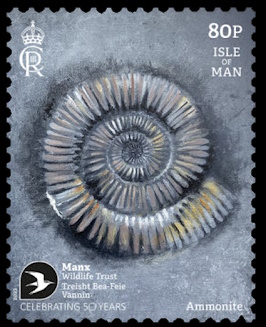 |
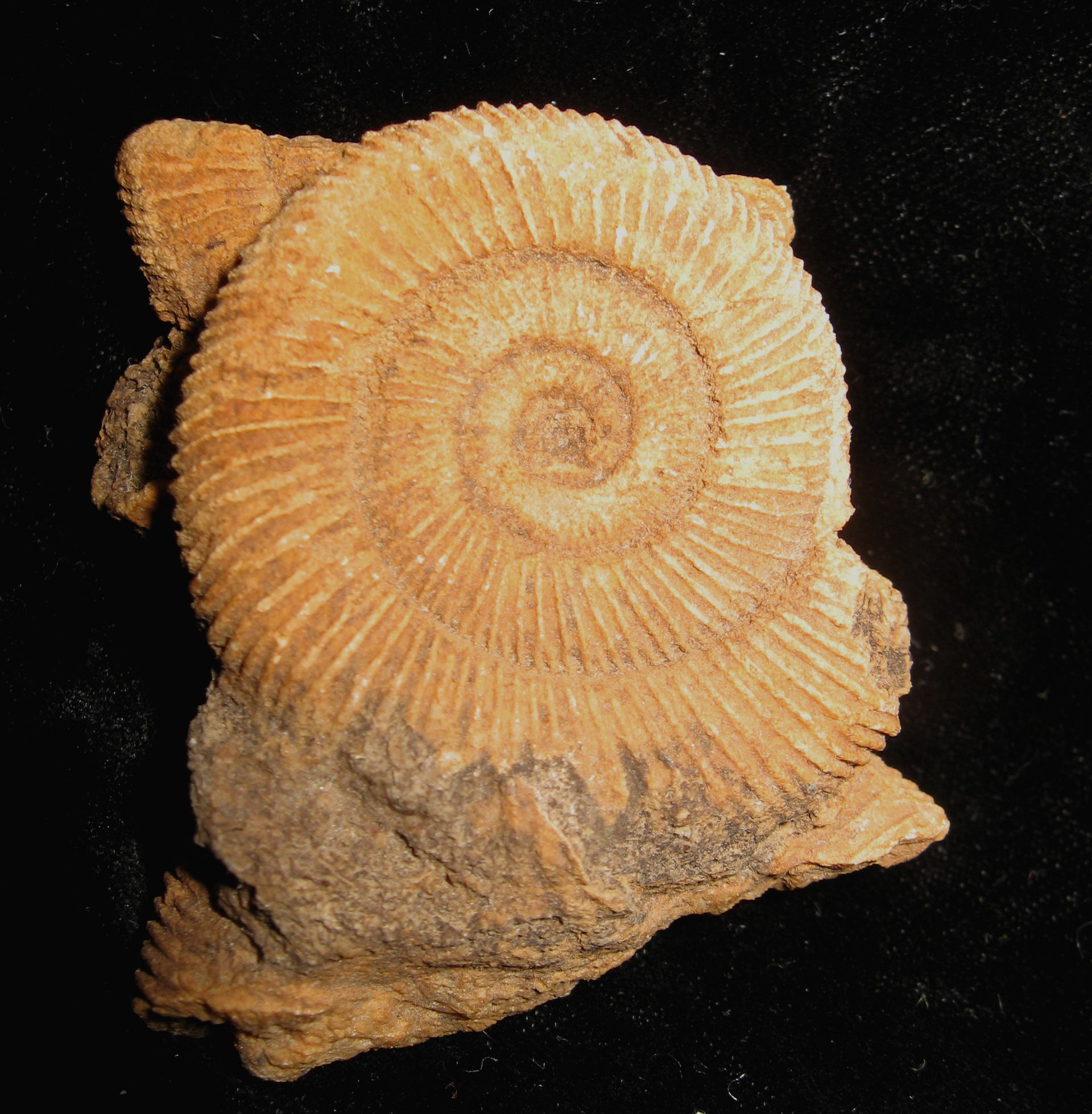 |
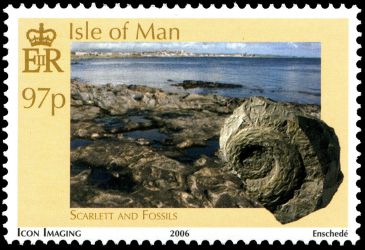 |
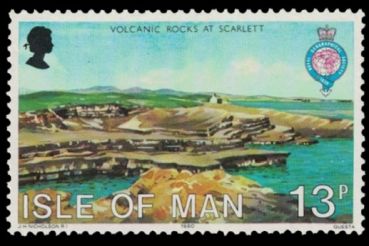 |
| Ammonite on stamp of Isle of Man 2023 - part of "Manx Wildlife Trust 50th Anniversary" set, MiNr.: 2965, Scott: 2278c. | Dactylioceras Ammonite. Inage credit: Wikimedia | Landscape of Scarlett and Ammonite on stamp of Isle of Man 2006 - part of "Isle of Man Society of Natural History and Archaeology" set, MiNr.: 1270, Scott: 1140 | Landscape of Scarlett on stamp of Isle of Man 1980 - part of "150 anniversary of Royal Geographical Society" set, MiNr.: 162, Scott: 166 |
Dactylioceras has been collected from almost every continent and was one of the most successful ammonite lineages ever. They are abundant throughout Europe, with exceptionally fine specimens found in England and Germany. Like many other ammonites, the genus Dactylioceras is extremely important in biostratigraphy, being a key index fossil for identifying their region of the Jurassic.
In 2006, An Ammonite from Scarlett was featured on postage stamp pf Isle of Man. At that time Prolecanitidae, Devonian–Triassic, Ammonite genus.
Other 9 stamps are:
| Little tern, Sternula albifrons: MWT’s logo includes the little tern, which breeds on coastal habitats of international importance on the Ayres (a reserve in the north of the Island). | Hedgehog, Erinaceus europaeus: Considered the gardener’s best friend, hedgehogs are becoming increasingly confused by our changing climate. MWT runs a citizen science programme using hedgehog recording tunnels to try and assess their numbers on Island. | Sundew, Drosera rotundifolia: the only carnivorous plant, found amongst mosses which form peat, an important carbon store on the Isle of Man. Much of the Island’s peatland is currently degraded and releasing carbon. MWT are working with the Manx Government to map and restore the Island’s peatland. |
| Skullcap, Scutellaria galericulata: A rare wildflower which MWT recently rediscovered in Island after an absence of 142 years. A perennial member of the mint family which loves wet, marshy grassland known locally to farmers by its Manx name, ’garee’. | Dark bush-cricket, Pholidoptera griseoaptera: The dark bush-cricket is one of only six species of Manx invertebrate which are legally protected. MWT is conducting annual monitoring to increase our awareness of this uncommon species. | Nudibranch, Polycera spp: MWT worked closely with the Manx Government to create the first Marine Nature Reserve in 2011 around Ramsey. The Island now boasts 10 of these marine protected areas covering over 50% of our inshore area. |
| Scarce crimson & gold moth, Pyrausta sanguinalis: A very rare micro-moth which is found only at the Ayres, in the north of the Island, and a few locations in Ireland. The larvae feed on wild thyme which is abundant across the Ayres National Nature Reserve. | Fly agaric fungus, Amanita muscaria: The classic fairy tale toadstool, this red and white fungus is often found in woodlands, typically growing beneath pines and birches. MWT Hairpin Woodland Park, part of the Ramsey Forest Project, aims to create a great place for people to visit and enjoy them. | Chough, Pyrrhocorax pyrrhocorax: The Isle of Man boasts a third of the combined British & Manx population, largely due to our more traditional farming practices. MWT works closely with farmers through the DEFA Agri-Environment Scheme to ensure continued protection of their habitat and food supply. |
Products
| FDC | Presentation-Pack | Sheets of gummed stamps |
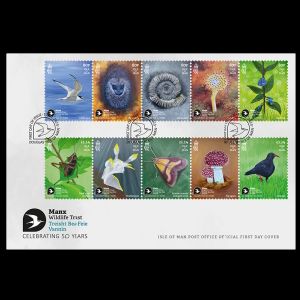 |
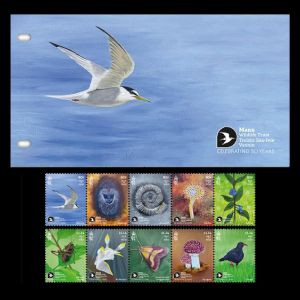 |
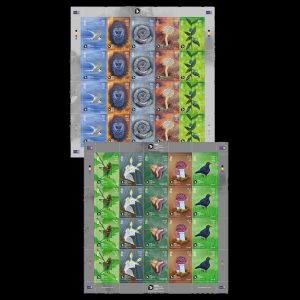 |
| Self-adhesive Booklet | Example of circulated covers | |
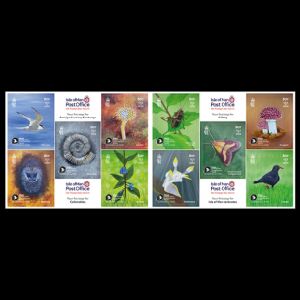 |
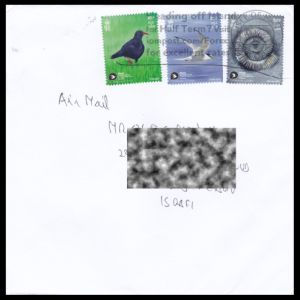 |
|
References

|
- Technical details and official press release: Post of Isle of Man, BBC.
- Manx Wildlife Trust: official website,
- Scarlett peninsula of Isle of Man: official website, isleofman.com, Manx Geological Survey.
- Clare Payne: Manx Wildlife Trust, official website,
- The Ammonite: Dactylioceras (Wikipedia),
Acknowledgements
Many thanks to Dr. Peter Voice, PhD Department of Geological and Environmental Sciences, Western Michigan University, USA, for his help in finding information and for review of a draft of this article.| <prev | back to index | next> |